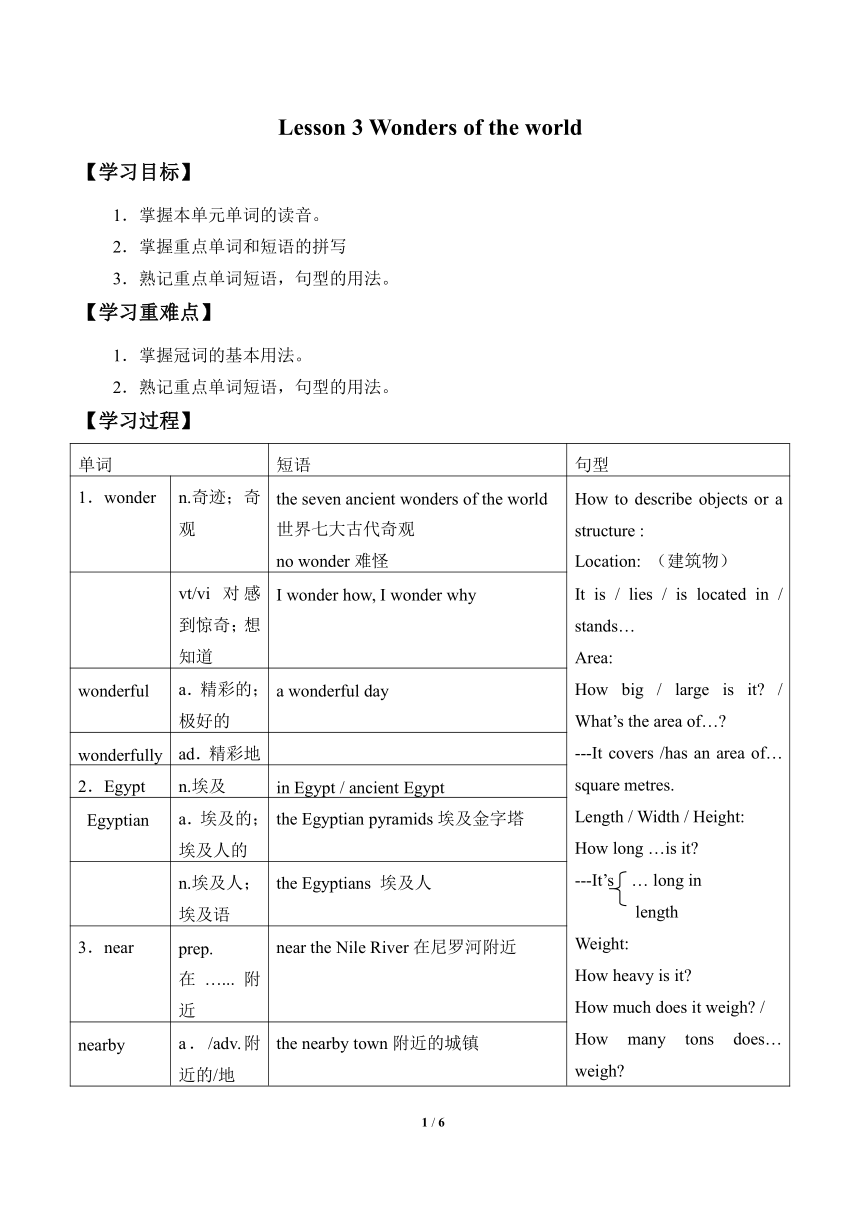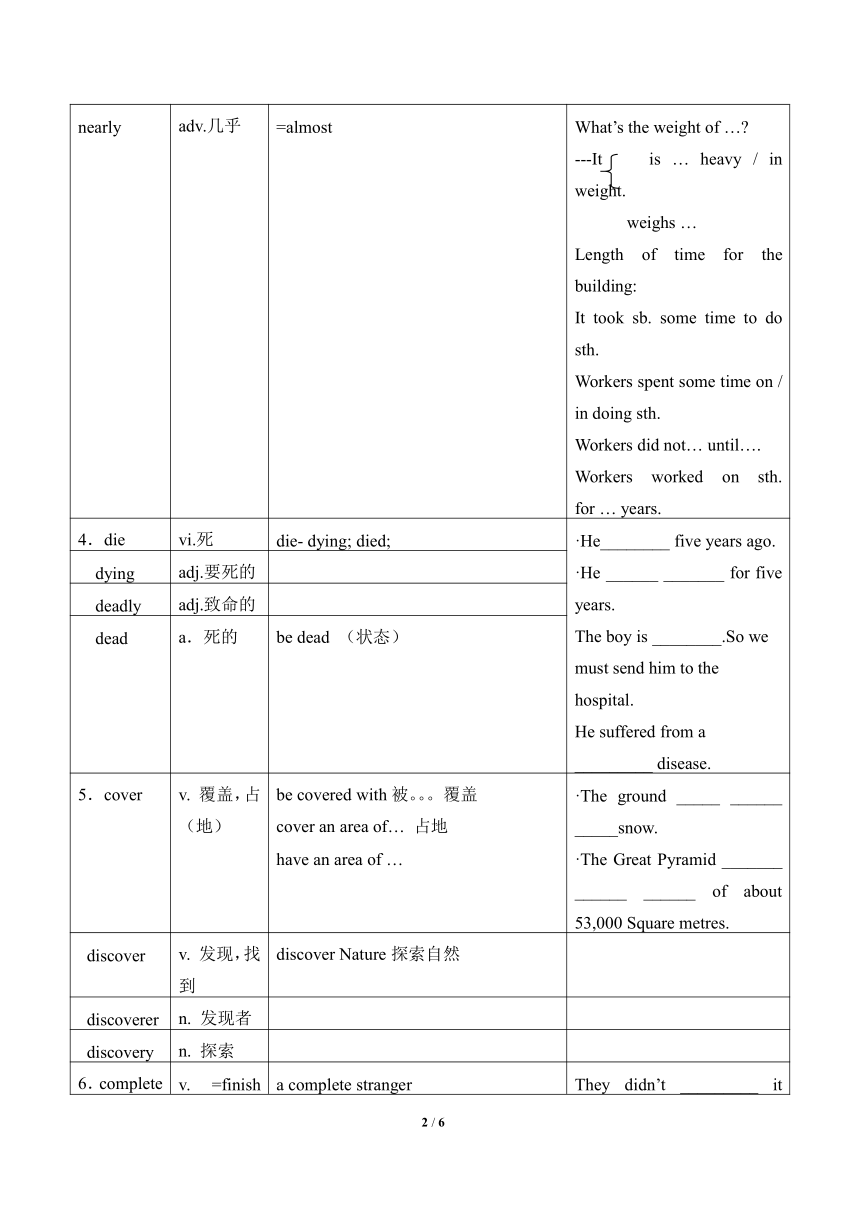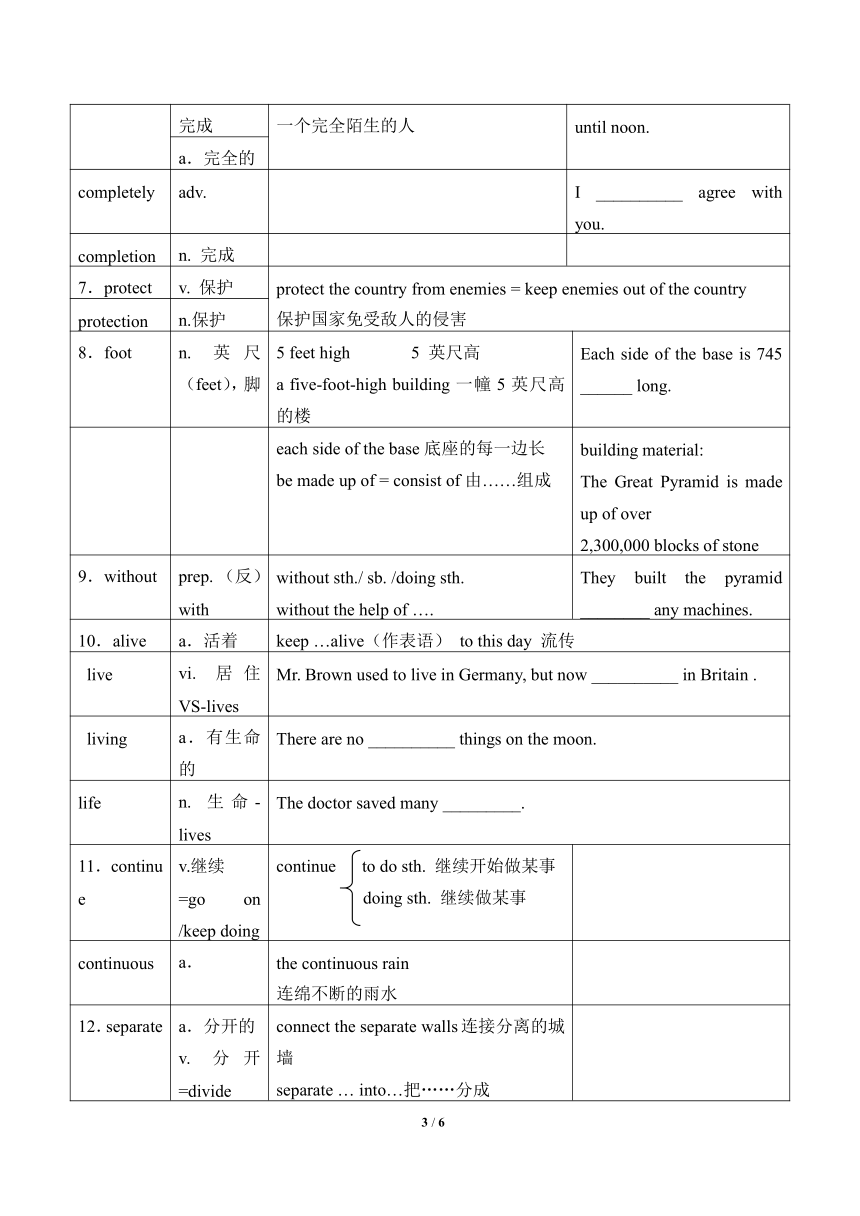Unit 3 Lesson 3 Wonders of the World 学案(无答案)
文档属性
| 名称 | Unit 3 Lesson 3 Wonders of the World 学案(无答案) |

|
|
| 格式 | zip | ||
| 文件大小 | 21.7KB | ||
| 资源类型 | 教案 | ||
| 版本资源 | 上海新世纪版 | ||
| 科目 | 英语 | ||
| 更新时间 | 2020-03-29 22:04:54 | ||
图片预览



文档简介
Lesson 3 Wonders of the world
【学习目标】
1.掌握本单元单词的读音。
2.掌握重点单词和短语的拼写
3.熟记重点单词短语,句型的用法。
【学习重难点】
1.掌握冠词的基本用法。
2.熟记重点单词短语,句型的用法。
【学习过程】
单词 短语 句型
1.wonder n.奇迹;奇观 the seven ancient wonders of the world 世界七大古代奇观 no wonder难怪 How to describe objects or a structure : Location: (建筑物) It is / lies / is located in / stands… Area: How big / large is it? / What’s the area of…? ---It covers /has an area of… square metres. Length / Width / Height: How long …is it?---It’s … long in lengthWeight:How heavy is it? How much does it weigh? / How many tons does… weigh? What’s the weight of …?---It is … heavy / in weight. weighs …Length of time for the building: It took sb. some time to do sth. Workers spent some time on / in doing sth. Workers did not… until…. Workers worked on sth. for … years.
vt/vi 对感到惊奇;想知道 I wonder how, I wonder why
wonderful a.精彩的;极好的 a wonderful day
wonderfully ad.精彩地
2.Egypt n.埃及 in Egypt / ancient Egypt
Egyptian a.埃及的;埃及人的 the Egyptian pyramids埃及金字塔
n.埃及人;埃及语 the Egyptians 埃及人
3.near prep.在…...附近 near the Nile River在尼罗河附近
nearby a./adv.附近的/地 the nearby town附近的城镇
nearly adv.几乎 =almost
4.die vi.死 die- dying; died; ·He________ five years ago.·He ______ _______ for five years.The boy is ________.So we must send him to the hospital.He suffered from a _________ disease.
dying adj.要死的
deadly adj.致命的 S
dead a.死的 be dead (状态)
5.cover v. 覆盖,占(地) be covered with被。。。覆盖 cover an area of… 占地 have an area of … ·The ground _____ ______ _____snow. ·The Great Pyramid _______ ______ ______ of about 53,000 Square metres.
discover v. 发现,找到 discover Nature探索自然
discoverer n. 发现者
discovery n. 探索
6.complete v. =finish完成 a complete stranger 一个完全陌生的人 They didn’t _________ it until noon.
a.完全的
completely adv. I __________ agree with you.
completion n. 完成
7.protect v. 保护 protect the country from enemies = keep enemies out of the country 保护国家免受敌人的侵害
protection n.保护
8.foot n. 英尺(feet),脚 5 feet high 5 英尺高a five-foot-high building一幢5英尺高的楼 Each side of the base is 745 ______ long.
each side of the base底座的每一边长 be made up of = consist of由……组成 building material:The Great Pyramid is made up of over 2,300,000 blocks of stone
9.without prep. (反)with without sth./ sb. /doing sth. without the help of …. They built the pyramid ________ any machines.
10.alive a.活着 keep …alive(作表语) to this day 流传
live vi. 居住 VS-lives Mr. Brown used to live in Germany, but now __________ in Britain .
living a.有生命的 There are no __________ things on the moon.
life n. 生命- lives The doctor saved many _________.
11.continue v.继续 =go on /keep doing continue to do sth. 继续开始做某事 doing sth. 继续做某事
continuous a. the continuous rain连绵不断的雨水
12.separate a.分开的 v. 分开=divide connect the separate walls连接分离的城墙 separate … into…把……分成
separation n. 分离
separated a.分开的
13.wisdom n. 智慧 the symbol of the wisdom of the ancient Chinese古代中国人智慧的象征
wise a.精明的
the Statue of Liberty 自由女神 the Eiffel Tower(in Pairs) 埃菲尔铁塔 the Golden Gate Bridge (in San Francisco) 金门大桥 begin from Shanhaiguan Pass on the east coast从东海岸的山海关开始 end at Jiayuguan Pass in the Gobi Desert 以戈壁的嘉峪关.结束 the same distance as that between London and Moscow…与伦敦和莫斯科之间一样的距离keep the enemies out of China.add to the wall’s height and length增加墙的高度和长度during the later dynasties 在后朝数代期间 a world-famous tourist attraction. 世界著名的旅游圣地a tour guide 一个导游
长 宽 高 重 深 厚 大和小 老的
a. long wide high heavy deep thick big/small old
n. ?length ?width ?height ?weight ?depth ?thickness size age
国名/洲名 国人/国人的 人(复数)
Africa African African(s)
America American American(s)
Canada Canadian Canadian(s)
Egypt Egyptian Egyptian(s)
Europe European European(s)
Germany German German (s)
India Indian Indian(s)
冠词
1.定冠词的基本用法:
1)表示特指。有限定词,谈话双方都熟悉的人或事物
如:The man with a flower in his hand is Jack. (手上拿着一朵花的男人是杰克)
如:Look at the blackboard, Lily. (莉莉,请看黑板。)
2)上文提到过的人或事物。
如:There is a man under the tree. The man is called Robert. (树下有个人, 那个人叫罗伯特。)
3) 表示世界上独一无二的事物。
如:The earth turns around the sun. (地球绕太阳旋转。)
4) 用在表示方位的名词前面。
如:There will be strong wind to the south of the Yangtze River. (长江以南地区将会刮大风。)
5) 在序数词和形容词最高级的前面。
如:Who is the first one to go? (谁第一个去?)
Of all the stars, the sun is the nearest to the earth. (在所有的恒星之中太阳离地球最近)
6) 常用在乐器名称的前面。
如:He began to play the violin at the age of 5.(五岁时他开始拉小提琴)
7) 用在专有名词前:★地理名(太平洋)
江河海洋:the Yangtze(长江),the Thames(泰晤士河),the East China Sea(东海),the Pacific
山脉群岛:the Rocky Mountains(落基山脉), the Philippines(菲律宾群岛)
海峡海湾:the English Channel(英吉利海峡),the Persian Gulf(波斯湾)
★含有普通名词
国家名称:the People’s Republic of China (中国人民共和国),the United States of America(美利坚合众国)
建筑物the British Museum(大英博物馆),the Great Wall(长城),the Jingmao Building (金茂大厦)
组织机构:the United nations(联合国),the National People’s Congress(全国人民代表大会)
★用在姓氏之前表示一家人。如:The Greens are going to Mount Emei next month. (下个月格林一家要去峨眉山)
8)与形容词或分词连用表示一类人。如:the rich 富人; the living 生者。
9)表示种类。如: The horse is a useful animal.
10)same之前一般用the。如:Lucy and Lily look the same. (露西和莉莉看上去长得一样)
11)表示所有,相当于物主代词,用在表示身体部位的名词前。
如:She caught me by the arm.(她抓住了我的手臂)
12)用定冠词的习语
如:at the same time (与此同时), make the bed(铺床), in the end(最后), all the time(一直)等。
2.零冠词的情况:
1) 专有名词之前不加冠词:
表示地点(州、国家、城市、街道、广场、公园、学校等)
如:Asia, China, Paris, Fifth Avenue, Tian’anmen Square, Hyde Park, Harvard University
表示时间(季节、月份、星期、节日等)
如:on Monday, February 18,1995, in spring, on Children’s Day
表示国籍、语言、学科。如:learn French
2) 泛指的不可数名词。
如:Snow is white. (是比较 The snow on the ground is thick)
3)球类、棋类、牌类、三餐饭的名词前。
如: play football, play chess, have lunch
4) 名词前已有指示、物主或不定代词作定语。
如:My pen is much more expensive than yours.
5) 复数名词表示种类。如:Men are cleverer than monkeys.(人比猴子聪明)
6) 习惯用语中不用。如:go to school/bed, take care of
4 / 6
同课章节目录
- Unit 1 Modern Technology
- Lesson 1 Computers
- Lesson 2 Robots
- Lesson 3 Household Appliances
- Progress Check 1
- Unit 2 Culture and Customs
- Lesson 1 Visiting a British Family
- Lesson 2 Eating Out
- Progress Check 2
- Unit 3 Knowledge of Common Interest
- Lesson 1 Idioms with Body Parts
- Lesson 2 Exhibitions and Museums
- Lesson 3 Wonders of the World
- Progress Check 3
- Unit 4 Animals and Plants
- Lesson 1 A Visit to an Agricultural Park
- Lesson 2 For or Against Keeping Pets?
- Progress Check 4
